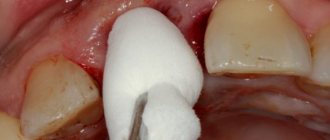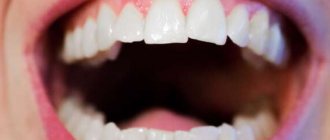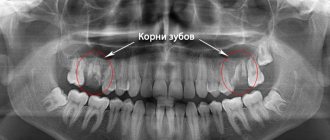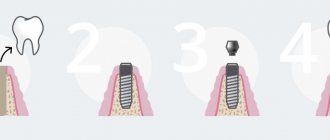Everyone knows that calcium is an essential trace element for the construction of human teeth and bones. Also, it is involved in the regulation of blood pressure, conduction of nerve impulses, controls blood clotting, etc. Lack of calcium negatively affects the functioning of the entire body. Long-term calcium deficiency, in addition to general negative consequences, in 95% of cases leads to caries, dental disease and gradual “softening” and destruction of enamel.
Like other microelements, calcium is not synthesized in our body on its own. It can only be obtained from outside:
- with food;
- as part of mineral complexes;
- through the use of special oral care products.
Let's try to consider the advantages and disadvantages of all three options for replenishing calcium deficiency for teeth.
What is calcium filling?
For filling, a special composition is used - copper-calcium hydroxide. It has the consistency of a paste, which is injected into the recess with a special tool - a channel filler.
Calcium hydroxide paste completely closes the canal, preventing pathogens from getting inside
To ensure that there are no voids left in the cavity, the tooth is lightly exposed to electric current.
This method performs a therapeutic function: it disinfects tooth tissue, killing bacteria.
The patient walks with this calcium filling for some time. Then the dentist takes it out, rinses it, thoroughly dries the root canal and performs the final filling with a permanent filling.
Procedure for filling teeth with calcium
A filling filled with calcium is temporary and, after a period determined by the doctor, changes to a permanent
one. Installation of a calcium filling involves several stages:
- The doctor mixes calcium powder with distilled water and glycerin to obtain a homogeneous paste.
- Before filling, the doctor cleans the root canal and treats it with special preparations.
- Using a channel filler, the resulting paste is introduced into the recess
- To ensure that the substance adheres tightly to the walls of the canal, it is compacted with a pin, and then the hole is hermetically sealed.
As mentioned above, a calcium filling is temporary. How long it will stay in the tooth is decided by the doctor, based on the specific clinical case. After the prescribed period has expired, the dentist removes the temporary filling and places a permanent one in its place.
Beneficial properties of calcium
Preparations containing calcium have an antibacterial effect. Most dental diseases are caused by bacteria that actively multiply in an acidic environment. But an alkaline environment, on the contrary, kills them.
Calcium helps create an alkaline environment in the tooth cavity that is unsuitable for bacterial activity.
To obtain a filling paste, calcium hydroxide powder is diluted with saline solution. Interaction with liquid leads to the release of hydroxyl ions, which kill pathogenic bacteria.
Getting calcium from food
The richest in calcium are:
- dairy and fermented milk products (milk, cottage cheese, kefir, fermented baked milk, sour cream and others);
- cheeses, especially hard varieties;
- different breeds of fish and seafood;
- sesame, as well as many other seeds and nuts;
- white and other types of cabbage;
- citrus fruits;
- greens (parsley, basil, dill, etc.), leafy vegetables;
- beans (green and white).
These products, in varying proportions, are present in the diet of probably every person. But the main difficulty in obtaining calcium only from food is that many foods contain this trace element in very small doses. To get 1 - 1.2 g of calcium (the required daily intake for an adult), you will need to eat a fairly large amount of food. Even with a very rational menu, the energy value of such a diet will be at least 3000 kcal, which for most people significantly exceeds the recommended daily calorie intake. In addition, for good absorption of calcium, other microelements are required. Balancing everything in the right proportion at home on your own is almost impossible.
How does calcium work?
Staying in the canal for a certain time, calcium completely kills bacteria living in the tooth
After entering the root canal, the calcium mixture begins to interact with the tissues and microflora of the tooth. The oxide penetrates into the dentin and pulp. When the substance remains inside the canal for a long time, it completely kills the bacteria living in it. After such exposure, the doctor can safely carry out further treatment or fill the canal.
Medical Internet conferences
Relevance. Calcium is one of the main components that make up hydroxyapatite crystals, which represent the mineral basis of hard dental tissues. There are a large number of Ca drugs of different generations on the pharmacological market, however, their price categories are different. Prevention in children should be aimed at creating optimal conditions for increasing tooth resistance and enamel maturation. It follows that for the correct formation of teeth, when the processes of primary mineralization are not yet completed, endogenous prophylaxis with calcium preparations is necessary. [1].
Purpose: to choose the most effective Ca preparation for endogenous caries prevention.
Tasks:
1) study the pharmacological features, indications, contraindications of the drug “Calcium Gluconate” as a representative of monodrugs;
2) study the pharmacological features, indications, contraindications of the drug “Calcium - D3 Nycomed” as a representative of combined calcium preparations;
3) study the pharmacological features, indications, contraindications of the drug “Kalcemin” as a representative of multivitamin preparations.
4) comparative analysis of these drugs.
Materials and methods. In the process of work, the content of dental journals was studied, an analysis of domestic and foreign articles, as well as various websites and brochures was carried out.
Results and discussion. Endogenous prevention of caries is the introduction of Ca, P, F preparations, microelements and vitamins into the child’s body. Its main directions: 1) strengthening the child’s health (treatment of chronic diseases of organs and systems; 2) prescribing drugs P, Ca, F and other macro- and microelements in combination with vitamins in various specific dosages; 3) proper balanced nutrition of a child and a pregnant woman during the formation of mineralization of tooth enamel; Calcium is the most significant macronutrient required for the mineralization of enamel. The daily calcium requirement of a growing organism is 10 – 13 mg/kg. There are: 1) monopreparations that contain only Ca salts (calcium lactate, calcium glycerophosphate, calcium gluconate); 2) combined preparations containing vitamin D or C, Ca salts, and also mineral elements (boron, zinc, magnesium); 3) multivitamin preparations. Ca gluconate is produced in tablet form of 0.25 and 0.5 g. Pharmacological action: eliminates calcium deficiency, exhibits antiallergic, hemostatic, detoxification, anti-inflammatory effects. Pharmacodynamics: eliminates calcium deficiency. Ca ions take part in the propagation of nerve impulses, in the contraction of skeletal and smooth muscles, myocardium, and in blood clotting. Pharmacokinetics: after the drug has been taken, it begins to be rapidly absorbed into the gastrointestinal tract, penetrating into the blood, where it is available in ionized and bound form. It is removed by the kidneys (20%) and with the contents of the intestines (80%). Indications: 1) hypocalcemia; 2) hypoparathyroidism; 3) rickets; 4) increased need for Ca ions (pregnancy, breastfeeding, increased body growth); 5) a small amount of Ca ions in food, lack of its metabolism; 6) intoxication with Mg salts, hydrofluoric and oxalic acids. Contraindications: 1) hypersensitivity to the components of the drug. Children under 1 year are given 0.5 g, 2 – 4 years – 1 year, 5 – 6 years – 1.5 g, 7 – 9 years – 1.5 – 2 years, 10 – 14 years – 3 – 4 g/day. Course – 1 month [2]. Anti-carious effect – remineralizing role to prevent caries and non-carious lesions. Clinically, a child’s reduced calcium intake may not be reflected in anything for a long time. But with a lack of calcium to normalize its content in the blood and create metabolic processes in the body, it begins to be washed out of the bones and teeth. Ultimately, this causes a decrease in the rate of formation of the skeletal system, improper formation of hydroxyapatites, and in acute periods of life (first year, 1-2 years, 6-7 years, 12-14 years) leads to the formation of osteopenic syndrome [3,4] . The child's compensatory capabilities to compensate for calcium deficiency are small. This is confirmed by the results of studies conducted by I.V. Kovach and co-authors, who discovered a special correlation between the mineral density of bone tissue and the intensity of the carious process in children 3-6 years of age, i.e. the lower the mineral density of bone tissue, the higher the intensity of dental caries [5]. Many scientists say that there is a close connection between somatic pathology and calcium metabolism disorders. The main ones are diseases of the kidneys (chronic renal failure, idiopathic hypercalciuria) and gastrointestinal tract (malabsorption syndrome in various diseases, duodenal ulcer), endocrine organs (diabetes mellitus). Inflammatory diseases also have a great influence on calcium metabolism. pain (osteomyelitis ), various toxic substances, radionuclides [6,7]. Of the examined children aged 5-16 years, epidemiological experiments by Russian scientists revealed the presence of osteopenia or osteoporosis in 10-30% (depending on age) [8]. They are manifested by a number of symptoms: general weakness, increased fatigue, decreased academic performance, developing dental diseases (caries, periodontitis), paresthesia and muscle twitching, dry skin, brittle nails and hair, changes in posture [9,10]. Thus, any conditions that involve a low intake of Ca or an increased consumption of Ca lead to the formation of hydroxyapatite crystals of irregular structure and properties in the hard tissues of teeth, which will have a detrimental effect on their resistance to caries. Therefore, there is an obvious need for medicinal endogenous prevention of caries in permanent teeth in children, especially during periods of rapid growth, using new calcium preparations in combination with vitamins and microelements that support its absorption in the development of mineralization of hard tissues. Particularly cheap among them are simple 1st generation calcium preparations (gluconate, lactate, glycerophosphate, citrate), which contain only calcium compounds. Still, synchronous intake of vitamin D is necessary, which was taken into account when creating calcium preparations of the 2nd generation (Calcium-D3 Nycomed, Vitrum Calcium (Unifarm, Inc., USA), Calcevid (Beres)). The bioavailability of calcium increased due to this combination, which affected the increase in the effectiveness of preventive measures [11-14]. "Calcium - D3 Nycomed" is a drug that regulates the metabolism of calcium and phosphorus. The components are calcium carbonate (500 mg) and vitamin D3 (200 IU). The auxiliary part includes: sorbitol, various flavoring additives, povidone, magnesium stearate and aspartame. It is produced in the form of chewable tablets with mint or orange flavor. Pharmacological action: improves the metabolism of calcium and phosphorus in the body and compensates for the deficiency of the main structural element. The biochemical role of calcium lies in the physiological construction of bone tissue, mineralization of teeth, the processes of coagulation and transmission of nerve impulses, and the implementation of muscle contractions. Pharmacodynamics: reduces resorption and increases bone density, replenishing calcium and vitamin D3 in the body, necessary for the mineralization of teeth. It is produced in the form of chewable tablets with mint or orange flavor. Pharmacokinetics: 1) Ca (absorption – 30% of the dose taken; distribution and metabolism – 99% Ca is concentrated in the rigid structure of bones and teeth, 1% is found in intracellular and extracellular fluids, 50% of the total Ca content in the blood appears physiologically active ionized form, of which approximately 10% is composed of phosphates and other anions, the remaining 40% is associated with proteins, primarily albumin; excretion - Ca is excreted through the intestines, kidneys and sweat glands. 2) Vitamin D3 (absorption - about 80% of the dose taken in the small intestine; distribution and metabolism - circulates in the blood in a bound state with a special globulin, metabolized in the liver, then accumulates in adipose and muscle tissue; removed through the intestines and kidneys. Indications: 1) prevention and treatment of calcium deficiency and vitamin D3; 2) prevention and complex therapy of osteoporosis and its complications. Contraindications: 1) hypercalcemia; 2) hypercalciuria; 3) hypervitaminosis D3; 4) severe renal failure; 5) hypersensitivity to the drug. Directions for use and dosage: adults and children over 12 years old - 1 tablet 2 - 3 times a day, children from 5 to 12 years old - 1 - 2 tablets per day, children from 3 to 5 - as recommended by a doctor. Anti-carious effect - for the prevention and treatment of carious and non-carious lesions, periodontal diseases, well suited for people with normal bone mineral density. Calcium-D3 Nycomed prevents a decrease in the number of chalk spots and an increase in enamel remineralization, activation of bone tissue remodeling processes and inhibition of its resorption [15-19]. Nowadays, the most effective are calcium preparations of the 3rd generation, which contain, in addition to calcium and vitamin D compounds, a number of vitamins and microelements that affect mineral metabolism (Kaltsinova (KRKA), Kalcemin (Sagmel), Biocalcevit). “Calcemin”, each tablet contains 842 mg of calcium citrate and 202 mg of calcium carbonate (250 mg of elemental calcium), 50 IU of vitamin D, 2 mg of zinc, 0.5 mg of manganese, 50 mcg of boron. The citrate and carbonate present in Kalcemin belong to the group of salts with a high content of simple Ca. At the same time, calcium citrate reduces the risk of stone accumulation in the urinary tract, hence it reduces the activity of parathyroid hormone and is absorbed by itself. Pharmacological action: replenishes calcium deficiency, regulates calcium-phosphorus metabolism, replenishes the deficiency of vitamin D, macro- and microelements. Pharmacodynamics: combination drug. Increases the resistance of hard dental tissues, prevents diseases of the musculoskeletal system. There are no data on pharmacokinetics. Indications: 1) prevention and treatment of osteoporosis; 2) replenishment of the deficiency of Ca and microelements in children, pregnant women and during breastfeeding. Contraindications: 1) urolithiasis; 2) hypercalcemia; 3) hypercalciuria; 4) hypersensitivity to the components of the drug. The anticarious effect is due to its ability to increase the resistance of tooth enamel, as well as its effect on mineral metabolism and on the body as a whole. There is no data on the effectiveness of using Calcemin for the prevention and treatment of lesions of hard dental tissues in pregnant women and children under 6 years of age in scientific literature. At the same time, it should be noted that the combination of microelements in one Calcemin tablet is not entirely justified. Magnesium and calcium have a common transport system in the intestines, so they are absorbed 2 times less. The use of the mineral-vitamin complex “Kalcemina” has a beneficial effect on the acid-base balance of the oral cavity, normalizes the processes of de- and remineralization in the enamel-saliva system, thereby reducing the intensity of caries development in adolescents [20-25].
Conclusions:
1) A special feature of the drug “Calcium Gluconate” is its low cost and the possibility of use in children under 1 year of age. The disadvantage was an overdose, with the development of hypercalcemia with deposition of Ca salts
2) A special feature of the drug “Calcium – D3 Nycomed” is the rapid absorption of the drug in the oral cavity and its pleasant taste. The downside was the presence of aspartame, which is not recommended for pregnant women.
3) A special feature of the drug “Kalcemin” was the content of vitamins and minerals necessary for humans, intended for use during pregnancy. Disadvantage: possible development of an allergic reaction.
4) The largest number of positive criteria is noted for the drug “Kalcemin”: it contains a complex of vitamins and minerals, a minimum of side effects, and contraindications. The most effective drug for endogenous prevention is Kalcemin.











